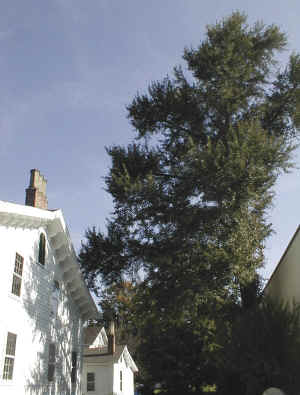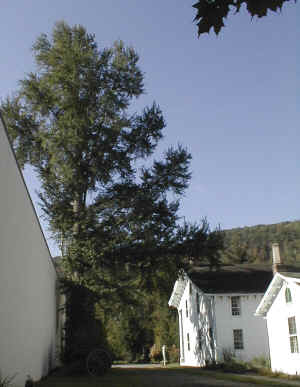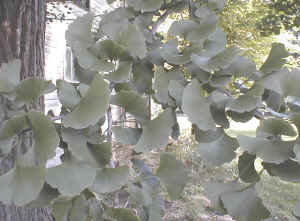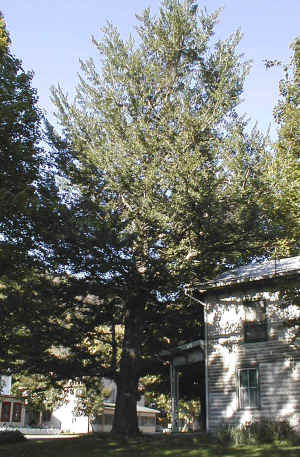
|
October
2000 Feature - by Muriel Pons,
Prattsville Town Historian
The friends of
the Zadock Pratt Museum are talking about their ginkgo tree these
days. It's the same "Ginkgo biloba" that is features
in so many health articles. But the Friends' interest is in the
historic aspect of the ginkgo tree on the Museum grounds, not its
herbal properties.
Although the general public may not be aware of it, the ginkgo tree is
not a recent addition to the Museum site. Not long after Zadock
Pratt built his house in 1824, which is now the Museum, he also
planted the ginkgo tree. Since Pratt's wide-ranging interests
included foreign plants, he no doubt secured the young seedling from
the Orient.
It now stands high
above the adjacent supermarket property, on the right side of
the Museum's Carriage House driveway.
The Pratt Ginkgo tree is about 175 years old, but that's hardly
anything to a ginkgo. In China today there are specimens
3,000 years old, and ginkgos have been cultivated for centuries
in isolated temple gardens there. |
 |
|
In
the botanical world, ginkgo trees are the only survivors from the
Ginkoacea family of plants, a group that stretches back about 200
million years or so. As tree species go, it is a living
dinosaur!
Aside from its longevity, the ginkgo tree is most noticeable for the
shape of its leaves. They are fan-shaped, and each has two lobes
with a notch in between. It is the two lobes which gives the
tree its species name "biloba", meaning literally "two
lobes".
The leaves have also been described as moth-shaped, and some have
referred to the ginkgo species as the "duck-foot tree"
because of the shape and weblike veining in the leaves. Perhaps
the best known alternative name over the years has been
"maidenhair tree" from the way the leaves are supported on a
spray of stems like floating maidenhair fern fronds.
Regardless
of the creativity of the names, however, the leaves are almost
everlasting once they fall to the ground. They plaster
themselves to every flat surface they may land on, a true gardener's
raking nightmare. Never-the-less, the foliage is one of the most
attractive features of the ginkgo, and there are some varieties that
have been developed for green, yellow, orange or mottled coloring in
autumn.
The
thick, ridge-covered, interlaced gray bark seems to have found no
particular use to mankind, nor does the wood, except for handcrafting
in China, and for firewood.
As
for planting the trees for nursery purposes, American cities invested
in young ginkgo trees to line streets in the last half-century or
so. They are free from insect pests and diseases, and grow fast
in the first few years. They also withstand air pollution.
|

Our ginkgo tree is a male tree
|
|
In following this trend for street
side beautification, most municipalities, including some in
Greene County, have discovered the importance of answering the
question, is it a male tree or a female tree ?
The reason is because the
female trees, those with female flowers, produce a small
plum-like fruit which drop from the tree all over the
sidewalks. Pedestrians then have to tramp through the
slippery, foul-smelling mess.
The solution, of course, is to
plant male trees, those with male flowers, in city or urban
sidewalk conditions. The catch is that the botanical sex
of a ginkgo tress is not evident until it is about 20 years old,
and as many feet tall.
|
|

|
Many
female trees in urban settings usually end up getting removed once
they begin littering the sidewalk with the ginkgo fruit.
Ironically,
the roasted kernel of the plum-line fruit is an Oriental
delicacy. To those initiated to its flavor, the kernels would
seem, perhaps, warrant enough to not destroy the females.
Park
planners and estate dwellers who wish to leave a living botanical
legacy often choose a ginkgo, as it is thought to be one of the finest
"specimen" trees of the temperate zone.
Although
gawky in the early years, it becomes a pleasing shape with age,
somewhat columnar, and round-headed, with hanging branches. As
it matures, it grows more slowly, but the ginkgo can be 50-80 feet
tall, with a canopy 30-40 feet wide.
|
|
|
The Pratt Gingko is
about nine feet in circumference, and approximately 60 feet
high. In June 2000, Greene County Cornell Cooperative Extension
Agent Bob Beyfuss took a boring in the trunk at the Museum's request,
and found the tree to be well and still growing.
Pratt Museum President Janelle Maurer, in a recent newsletter,
stressed the importance of recognizing the Pratt Ginkgo as a
significant tree.
"We consider our
ginkgo a vital part of Prattsville history", Maurer said.
Most local histories indicate that Zadock Pratt had a string interest
in all aspects of horticulture, including the segments that would
today be considered horticulture and silvaculture.
The Pratt Museum invites
all to take a closer look at this living remnant from the life of
Zadock Pratt when visiting the Museum.
Although younger ginkgos
can be found on Main Street in Catskills, the large, ceremonial
"specimen" ginkgos are at Kew gardens of London and the
Temple Gardens in China.
Isn't Prattsville handier? Another large and tall, female gingko
tree is just down Main Street Prattsville, at the Basil
Becker house, shown on the right.
Call the Zadock Pratt
Museum for information. This story was first published in the
Windham Journal on August 3, 2000. Muriel
Pons is the Town Historian on Prattsville and the former President
of the Pratt Museum. |

|
|